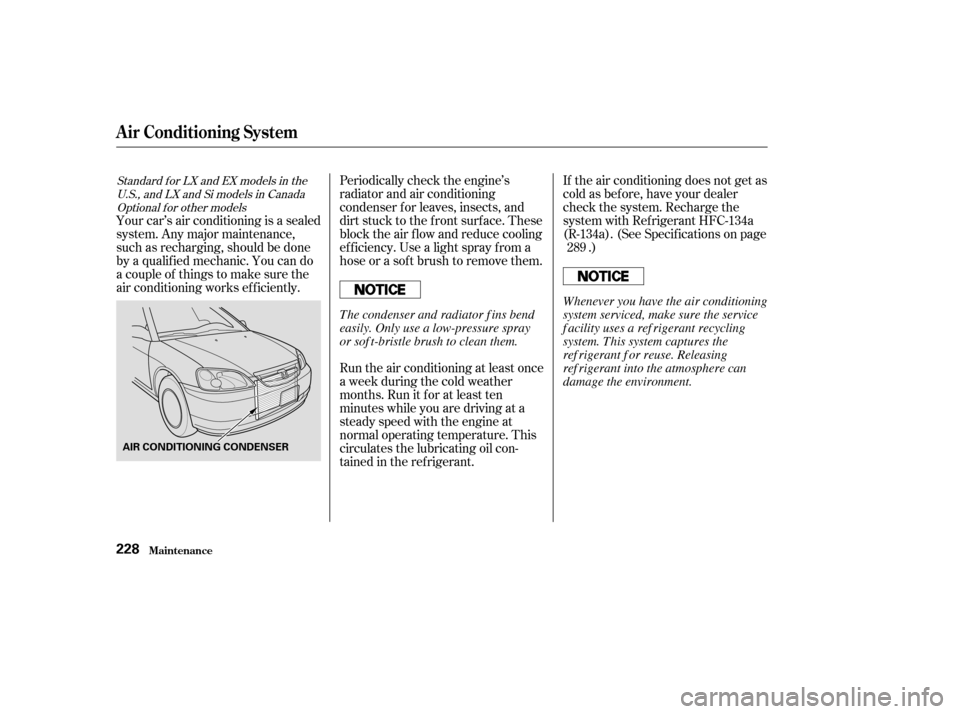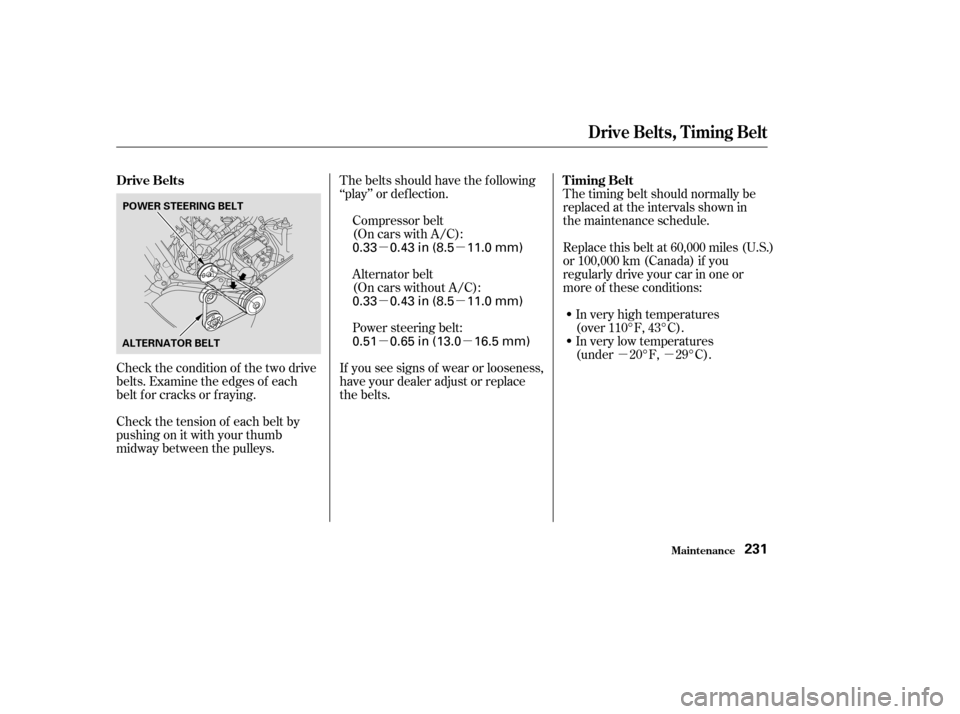Page 207 of 302
Check the f luid level with the engine
at normal operating temperature.Remove the dipstick (yellow loop)
f rom the transmission and wipe it
with a clean cloth.
Insert the dipstick all the way into
the transmission securely as
shown in the illustration.Remove the dipstick and check
the f luid level. It should be
between the upper and lower
marks.
Park the car on level ground. Shut
of f the engine. For accurate
results, wait at least 60 seconds,
andnomorethan90seconds,
af ter shutting of f the engine to
check the f luid level. 3. 4.
1. 2.
Automatic Transmission
T ransmission Fluid
Maint enance214
DIPSTICK (A/T)
LOWER MARK
UPPER MARK
DIPSTICK (CVT)
DIPSTICK (A/T)
�����—�����—�����y�
���������
���y���
�(���%�������y�����
���y
Page 209 of 302

Check the f luid level in the reser-
voirs monthly. There are up to two
reservoirs, depending on the model.
They are:
The brake f luid should be replaced
accordingtothetimeanddistance
recommendations in the mainte-
nance schedule.Brake f luid reservoir (all models)
Clutch f luid reservoir
(manual transmission only)
Check the f luid level with the
transmission at normal operating
temperature and the car sitting on
level ground. Remove the
transmission f iller bolt and caref ully
f eel inside the bolt hole with your
f inger. The f luid level should be up
to the edge of the bolt hole. If it is
not, add Honda Manual Transmis-
sion Fluid (MTF) until it starts to
run out of the hole. Reinstall the
f iller bolt and tighten it securely. If Honda MTF is not available, you
may use an SAE 10W-30 or 10W-40
viscosity motor oil with the API
Certif ication seal that says ‘‘FOR
GASOLINE ENGINES’’ as a
temporary replacement. However,
motor oil does not contain the proper
additives and continued use can
cause stiffer shifting. Replace as
soon as it is convenient.
The transmission should be drained
and ref illed with new f luid according
to the time and distance recommen-
dations in the maintenance schedule.
5-speed Manual Transmission
T ransmission Fluid
Maint enance216
FILLER BOLT
Correct Level
�����—�����—�����y�
�������������y���
�(���%�������y�����
���y
Page 221 of 302

Periodically check the engine’s
radiator and air conditioning
condenser f or leaves, insects, and
dirt stuck to the f ront surf ace. These
block the air f low and reduce cooling
ef f iciency. Use a light spray f rom a
hose or a sof t brush to remove them.If the air conditioning does not get as
cold as before, have your dealer
check the system. Recharge the
system with Ref rigerant HFC-134a
(R-134a). (See Specif ications on page
.)
Run the air conditioning at least once
a week during the cold weather
months. Run it f or at least ten
minutes while you are driving at a
steady speed with the engine at
normal operating temperature. This
circulates the lubricating oil con-
tained in the ref rigerant.
Your car’s air conditioning is a sealed
system. Any major maintenance,
such as recharging, should be done
by a qualif ied mechanic. You can do
a couple of things to make sure the
air conditioning works ef f iciently.
289Standard f or LX and EX models in the
U.S.,andLXandSimodelsinCanadaOptional f or other models
A ir Condit ioning Syst em
Maint enance228
AIR CONDITIONING CONDENSER
Whenever you have the air conditioning
system serviced, make sure the service
f acility uses a ref rigerant recycling
system. This system captures the
ref rigerant f or reuse. Releasing
ref rigerant into the atmosphere can
damage the environment.
The condenser and radiator f ins bend
easily. Only use a low-pressure spray
or sof t-bristle brush to clean them.
�����—�����—�����y�
���������
���y���
�(���%�������y�������
�y
Page 224 of 302

�µ�µ
�µ�µ
�µ�µ �µ�µ
The belts should have the f ollowing
‘‘play’’ or def lection. The timing belt should normally be
replaced at the intervals shown in
the maintenance schedule.
In very high temperatures
(over 110°F, 43°C).
In very low temperatures
(under 20°F, 29°C).
Replace this belt at 60,000 miles (U.S.)
or 100,000 km (Canada) if you
regularly drive your car in one or
more of these conditions:
Check the condition of the two drive
belts. Examine the edges of each
belt f or cracks or f raying. Power steering belt:
Alternator belt
(On cars without A/C):
Compressor belt
(On cars with A/C):
If you see signs of wear or looseness,
have your dealer adjust or replace
the belts.
Check the tension of each belt by
pushingonitwithyourthumb
midway between the pulleys.
Drive Belts
T iming Belt
Drive Belts, T iming Belt
Maint enance231
POWER STEERING BELT
ALTERNATOR BELT
0.51 0.65 in (13.0 16.5 mm)
0.33 0.43 in (8.5 11.0 mm)
0.33 0.43 in (8.5 11.0 mm)
�����—�����—�����y�
�������������y���
�(���%�������y���������y
Page 260 of 302

Your car can overheat f or several
reasons, such as lack of coolant or a
mechanical problem. The only
indication may be the temperature
gauge climbing to or above the red
mark. Or you may see steam or
spray coming f rom under the hood.
In either case, you should take
immediate action.
The pointer of your car’s tempera-
ture gauge should stay in the mid-
range under most conditions. It may
go higher if you are driving up a long
steep hill on a very hot day. If it
climbs to the red mark, you should
determine the reason.
Start your car. If the starter motor
still operates slowly, check the
jumper cable connections to make
sure they have good metal-to-
metal contact.
Once your car is running, discon-
nectthenegativecablefromyour
car, then from the booster battery.
Disconnect the positive cable f rom
your car, then the booster battery.
Keep the ends of the jumper cables
away from each other and any metal
on the car until all are disconnected.
Otherwise, you may cause an
electrical short.
7.
6.
CONT INUED
If Your Engine Overheats
Jump Starting, If Your Engine Overheats
T aking Care of t he Unexpect ed269
Steam and spray from an
overheated engine can
seriously scald you.
Do not open the hood if steam
is coming out.
Driving with the temperature gauge
pointer at the red mark can cause
serious damage to your engine.
�����—�����—�����y�
�������������y���
�(���%�������y���������y
Page 261 of 302

Saf ely pull to the side of the road.
Put the transmission in Neutral or
Park, and set the parking brake.
Turn of f the heating and cooling
system and all other accessories.
Turn on the hazard warning
indicators.
If you see steam and/or spray
coming f rom under the hood, turn
of f the engine.If you do not see steam or spray,
leave the engine running and
watch the temperature gauge. If
the high heat is due to overloading
(climbing a long, steep hill on a
hot day with the A/C running, f or
example), the engine should start
to cool down almost immediately.
If it does, wait until the tempera-
ture gauge comes down to the mid-
point then continue driving.
If the temperature gauge stays at
the red mark, turn of f the engine.
Wait until you see no more signs
of steam or spray, then open thehood.Look f or any obvious coolant leaks,
such as a split radiator hose.
Everything is still extremely hot,
so use caution. If you f ind a leak, it
must be repaired bef ore you
continue driving (see
on page ).
If you don’t f ind an obvious leak,
check the coolant level in the
radiator reserve tank (see page ). If the level is below the
MIN mark, add coolant to halfway
between the MIN and MAX marks.
1. 2.
3. 4. 5.6. 7.
161 283
Emergency
Towing
If Your Engine Overheats
T aking Care of t he Unexpect ed270
�����—�����—�����y�
�������������y���
�(���%�������y���������y
Page 262 of 302

If there was no coolant in the
reserve tank, you may also have to
add coolant to the radiator. Let the
engine cool down until the pointer
reaches the middle of the tempera-
ture gauge, or lower, bef ore check-
ing the radiator.Using gloves or a large heavy
cloth, turn the radiator cap
counterclockwise, without pushing
down, to the f irst stop. This
releases any remaining pressure in
the cooling system. After the
pressure releases, push down on
the cap and turn it until it comes
off.
Start the engine and set the
temperature control dial to
maximum. Add coolant to the
radiator up to the base of the f iller
neck. If you do not have the
proper coolant mixture available,
you can add plain water.
Remember to have the cooling
system drained and ref illed with
the proper mixture as soon as you
can.Put the radiator cap back on
tightly. Run the engine and watch
the temperature gauge. If it goes
back to the red mark, the engine
needs repair. (See
on page .)
If the temperature stays normal,
check the coolant level in the
radiator reserve tank. If it has
gone down, add coolant to the
MAX mark. Put the cap back on
tightly.
8.
9.
10. 11. 12.
283
Emergency
Towing
If Your Engine Overheats
T aking Care of t he Unexpect ed271
Removing the radiator cap
while the engine is hot can
cause the coolant to spray out,
seriously scalding you.
Always let the engine and
radiator cool down before
removing the radiator cap.
�����—�����—�����y�
���������
�
�y���
�(���%�������y���������y
Page 280 of 302

�µ
The treadwear grade is a compara-
tive rating based on the wear rate of
the tire when tested under controlled
conditions on a specif ied government
test course. For example, a tire
graded 150 would wear one and one-
half (1 1/2) times as well on the
government course as a tire graded
100. The relative perf ormance of
tires depends upon the actual condi-
tions of their use, however, and may
depart signif icantly f rom the norm
due to variations in driving habits,
service practices and dif f erences in
road characteristics and climate. The traction grades, f rom highest to
lowest, are AA, A, B, and C. Those
grades represent the tire’s ability to
stop on wet pavement as measured
under controlled conditions on
specif ied government test surf aces
of asphalt and concrete. A tire
marked C may have poor traction
perf ormance.
Warning: The traction grade
assignedtothistireisbasedon
straight-ahead braking traction tests,
and does not include acceleration,
cornering, hydroplaning, or peak
traction characteristics.
The tires on your car meet all U.S.
Federal Saf ety Requirements. All
tires are also graded for treadwear,
traction, and temperature perform-
ance according to Department of
Transportation (DOT) standards.
The f ollowing explains these
gradings.
All passenger car tires must conf orm
to Federal Saf ety Requirements in
addition to these grades.
Quality grades can be f ound where
applicable on the tire sidewall
between the tread shoulder and the
maximum section width. For
example: Treadwear Traction AA, A, B, C
T readwear 200
Traction AA
Temperature A
Unif orm T ire Quality Grading
DOT T ire Quality Grading (U.S. Cars)
T echnical Inf ormation290
�����—�����—�����y�
���������
���y���
�(���%�������y���������y